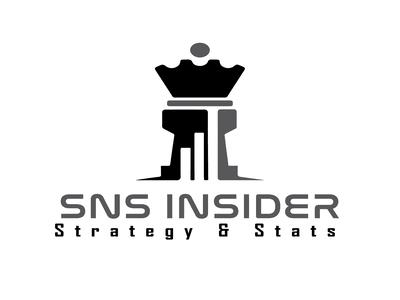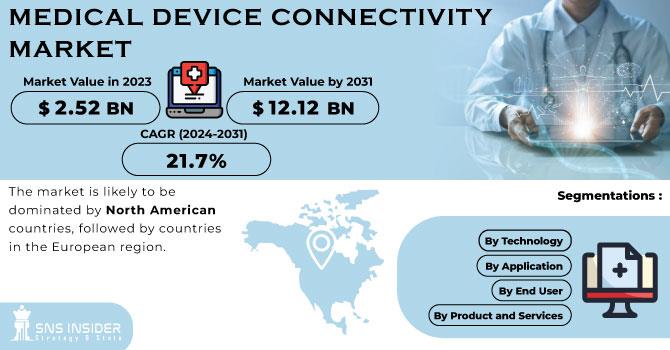
Medical Device Connectivity Market Projected To Reach USD 12.12 Billion By 2031 Driven By Telehealth Boom And Wireless Advancements

The Medical Device Connectivity Market is experiencing a surge, fueled by the increasing implementation of electronic health records, rising demand for telehealth solutions, and advancements in wireless technologies. This trend is expected to propel the market to reach a staggering USD 12.12 billion by 2031, reflecting a robust compound annual growth rate (CAGR) of 21.7% throughout the forecast period (2024-2031).
List of Medical Device Connectivity Market Companies Profiled in Report:
-
Baxter
Bridge-Tech
Cardiopulmonary Corporation
Cerner Corporation
Cisco Systems Inc.
Digi International Inc.
GE Healthcare Ltd.
Hill-Rom Services Inc.
Honeywell HomeMed LLC
iHealth Labs Inc.
Infosys Limited (India)
Lantronix Inc.
Masimo
MediCollector
Medtronic
Philips Healthcare
Qualcomm Inc.
Siemens Healthcare
Silex Technology America, Inc
Silicon & Software Systems Ltd.
Stryker
TE Connectivity
Download Free Sample Report of Medical Device Connectivity Market @
A Connected Future for Healthcare
The medical device connectivity market encompasses solutions that enable seamless communication between medical devices and healthcare IT (HCIT) systems. This facilitates remote patient monitoring, data collection, and transmission, empowering healthcare providers to deliver enhanced care and improve patient outcomes.
Rising Implementation of Electronic Health Records (EHRs) and Health Information Exchange (HIE) Systems
EHRs and HIE systems enable secure storage and exchange of patient data, fostering better care coordination and improved patient engagement. Medical device connectivity solutions integrate seamlessly with these systems, providing a holistic view of patient health.
Increasing Demand for Telehealth and Telemedicine Technologies
Telehealth services are revolutionizing healthcare delivery, allowing remote consultations and patient monitoring. Medical device connectivity plays a crucial role in telehealth by enabling real-time data transmission from medical devices to healthcare providers, facilitating informed clinical decisions.
A Market Driven by Policy and Innovation
Government initiatives worldwide are actively promoting the adoption of HCIT solutions, recognizing their potential to optimize healthcare delivery, reduce costs, and enhance patient outcomes.
The US Merit-based Incentive Payment System (MIPS) incentivizes clinicians to participate in Advanced Alternative Payment Models (APMs), promoting the use of digital health technologies.
The World Health Organization's (WHO) Global Strategy on Digital Health 2020-2025 emphasizes the application of digital health technologies to strengthen healthcare systems.
Germany's Digital Healthcare Act allows doctors to prescribe health apps for managing diagnosed conditions, with costs covered by statutory health insurance.
These initiatives, coupled with the ongoing consolidation within the healthcare sector, are creating fertile ground for the growth of the medical device connectivity market. As healthcare providers seek to expand patient reach and optimize resource utilization, connected medical devices emerge as a powerful tool.
Market Segmentation:
By Product and Services
-
Medical Device Connectivity Solutions
Implementation and Integration services
Support & maintenance services
Training services
Consulting services
By Technology
-
Wired technologies
Wireless technologies
Hybrid technologies
By Application
-
Vital signs & patient monitors
Anesthesia machines & Ventilators
Infusion pumps
By End User
-
Hospitals
Home Care Centers
Diagnostic & Imaging Centers
Ambulatory Care Centers
Wireless Technologies Take the Lead
The medical device connectivity market is segmented by technology, application, and end-user. Among technologies, the wireless segment is anticipated to witness the most significant growth.
Wireless technologies offer efficient data transmission capabilities, enabling real-time remote monitoring of patients. Regulatory bodies, like the US Food and Drug Administration (FDA), provide guidelines for developing and utilizing wireless medical devices, ensuring safety and efficacy.
Have Any Query? Ask Our Experts @

Medical Device Connectivity Market
Impact of Russia-Ukraine War:
The ongoing conflict between Russia and Ukraine is expected to have a moderate impact on the medical device connectivity market. Disruptions in the supply chain, particularly for electronic components, could lead to temporary shortages and price fluctuations. However, the long-term impact is expected to be minimal, as the underlying growth drivers of the market remain strong.
Economic Slowdown and its Effects:
An economic slowdown could potentially lead to budget constraints within healthcare institutions, impacting investments in new medical technologies. However, the long-term benefits of medical device connectivity, such as improved care efficiency and reduced healthcare costs, are likely to outweigh these short-term challenges.
North America is expected to hold a dominant market share throughout the forecast period
The increasing burden of chronic diseases in North America is creating a significant demand for telemedicine solutions. Telehealth, enabled by medical device connectivity, allows for remote patient monitoring and improved care management. This translates to better patient outcomes and a higher quality of life.
Telemedicine Cuts Costs and Improves Care
The adoption of telemedicine in North America is not just improving patient well-being; it's also leading to significant cost savings. Data highlights this trend:
A 2021 report by the Canadian Institute of Health Information shows a rise in Canadian healthcare expenditure from USD 301.5 billion in 2020 to USD 308.1 billion in 2021.
Similarly, the Centers for Medicare and Medicaid Services (CMS) reported a jump in US healthcare expenditure in 2022, reaching USD 4.3 trillion, a significant increase of USD 173 billion compared to the previous year.
This rise in healthcare spending highlights the potential cost-saving benefits of telemedicine, which is facilitated by medical device connectivity. As telemedicine becomes more widely adopted, the medical device connectivity market is expected to experience substantial growth.
Innovation Fuels Market Expansion:
Beyond the rise of chronic diseases, governments and companies in North America are actively promoting innovation in the medical device connectivity market. This fosters a supportive environment for market growth.
For instance, the US Food and Drug Administration's (FDA) Digital Health Center of Excellence (DHCoE) held a workshop in October 2021 focusing on transparency in artificial intelligence (AI) and machine learning (ML)-powered medical devices. This initiative signifies a commitment to fostering responsible development and high-quality digital health innovation, which ultimately benefits the medical device connectivity market.
Key Takeaways: A Glimpse into the Future of Medical Device Connectivity
-
Gain a comprehensive understanding of the projected market size and growth rate for the medical device connectivity market over the next seven years.
Identify the key factors driving market growth, such as the rising adoption of telehealth and advancements in wireless technologies.
Explore the performance of different market segments, including technologies, applications, and end-users, to identify areas of high potential.
Understand the geographical distribution of the market and the factors influencing regional growth dynamics.
Gain insights into the strategies of key players in the market, including their product offerings, partnerships, and future plans.
Purchase Medical Device Connectivity Market Report @
Table of Content
Chapter 1 Introduction
Chapter 2 Research Methodology
Chapter 3 Medical Device Connectivity Market Dynamics
Chapter 4 Impact Analysis (COVID-19, Ukraine- Russia war, Ongoing Recession on Major Economies)
Chapter 5 Value Chain Analysis
Chapter 6 Porter's 5 forces model
Chapter 7 PEST Analysis
Chapter 8 Medical Device Connectivity Market Segmentation, By Product and Services
Chapter 9 Medical Device Connectivity Market Segmentation, By Technology
Chapter 10 Medical Device Connectivity Market Segmentation, By Application
Chapter 11 Medical Device Connectivity Market Segmentation, By End User
Chapter 12 Regional Analysis
Chapter 13 Company profile
Chapter 14 Competitive Landscape
Chapter 15 Use Case and Best Practices
Chapter 16 Conclusion
Continued...
Other Trending Reports
Portable Ultrasound Market Outlook
Patient Engagement Solutions Market Outlook
Remote Patient Monitoring Market Outlook
About US:
SNS Insider has been a leader in data and analytics globally with its authentic consumer and market insights. The trust of our clients and business partners has always been at the center of who we are as a company. We are a business that leads the industry in innovation, and to support the success of our clients, our highly skilled engineers, consultants, and data scientists have consistently pushed the limits of the industry with innovative methodology and measuring technologies.
Contact Us:
Akash Anand – Head of Business Development & Strategy
...
Phone: +1-415-230-0044 (US) | +91-7798602273 (IND)

Legal Disclaimer:
MENAFN provides the
information “as is” without warranty of any kind. We do not accept
any responsibility or liability for the accuracy, content, images,
videos, licenses, completeness, legality, or reliability of the information
contained in this article. If you have any complaints or copyright
issues related to this article, kindly contact the provider above.
Most popular stories
Market Research

- Casper Network Advances Regulated Tokenization With ERC-3643 Standard
- Forex Expo Dubai Wins Guinness World Recordstm With 20,021 Visitors
- Superiorstar Prosperity Group Russell Hawthorne Highlights New Machine Learning Risk Framework
- Freedom Holding Corp. (FRHC) Shares Included In The Motley Fool's TMF Moneyball Portfolio
- Versus Trade Launches Master IB Program: Multi-Tier Commission Structure
- Ozzy Tyres Grows Their Monsta Terrain Gripper Tyres Performing In Australian Summers



















Comments
No comment